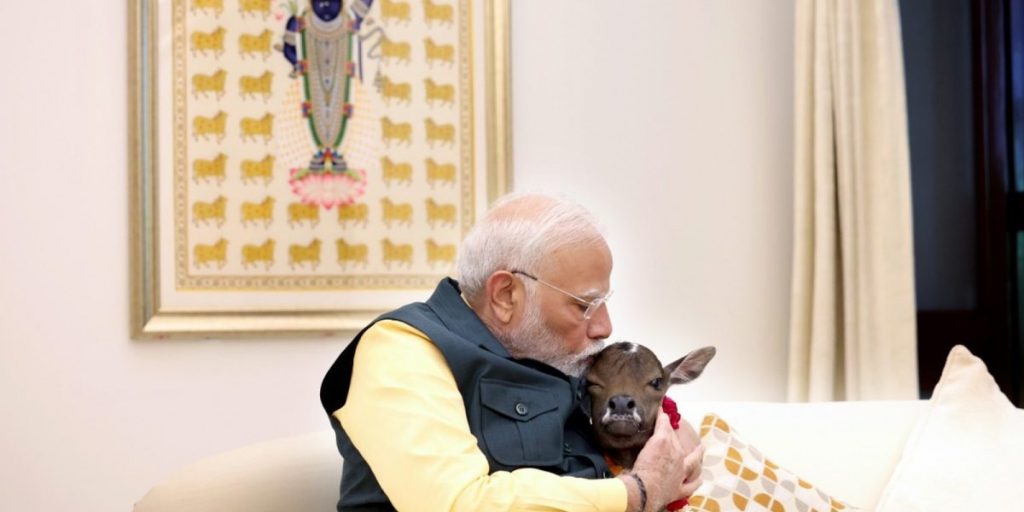Goa is abuzz with excitement as vintage bike and car owners, users, collectors and fans are decking […]

THE KISS OF DEATH!By Palash Krishna Mehrotra
In the News, Sep 28- Oct 04 2024 September 27, 2024The photograph of PM Modi kissing his pet calf, Deepjyoti, is no doubt very cute. It’s an aww moment. That said, the babies of all creatures are sweet-looking, from baby elephants to baby lizards, not to mention feather-light baby cockroaches and piglets with soft tendril tails.
But this is no ordinary calf. As the prime minister’s official X handle announced to the nation: “the beloved mother cow” had given birth to DJ, “It is said in our scriptures – ‘Gaavh Sarvasukh Pradaah’”. Given the holy underpin, it’s safe to assume that this was an immaculate conception. No bull was involved.
It’s not unusual to see single people develop OTT affection for animals and plants, in order to deal with their maternal/paternal instinct. If Vance can talk about unmarried cat ladies, why not unmarried calf dudes? Except that this is no ordinary animal.
As Al Jazeera reports: “Since 2014, when Modi first came to power, nearly 50 cow-related lynchings of Muslim men have been reported – most victims are poor farmers or daily wage workers, who left behind grieving families staring at an uncertain future. In nearly all such incidents, no cow meat was found, only the battered and tortured – and often lifeless – bodies of the victims.” Even homes are bulldozed on the suspicion there is beef in the fridge inside.
What about the optics of the act? Modi is kissing an animal considered sacred by Hindus, over which assaults, at times deadly, at others horribly humiliating for the victim, have taken place. In the context of the forthcoming assembly elections, this ostensibly harmless act of kissing a calf can only be seen as an act to shore up the Hindutva vote base. For Muslims, this is the kiss of death.
On August 27, a 26-year-old Muslim ragpicker, Sabir Malik was fatally lynched in the town of Charkhi Dadri, near Faridabad. A migrant from Bengal, he leaves behind his wife and a two-year-old toddler. Malik was killed over suspicion that he had consumed beef.
On September 3, a 72-year-old Muslim man was brutally thrashed by Hindu fellow travellers for allegedly carrying beef. He repeatedly insisted it was buffalo meat, categorically not on any ban list. Tibetan restaurants freely serve “buff”.
Then on September 6, there was the biryani-in-a-tiffin row in Amroha, where a school principal went after a seven-year-old boy for bringing biryani as his packed lunch to school. The problem here was not beef, but non-veg food in general. The hapless Muslim must be really confused: is the problem with eating cow, oxen, or buffalo, or chicken, goat and fish in general?
According to data from the National Family and Health Survey-V (2019-2021), meat consumption in India is actually rising. 45.1% women and 57% men said they consume fish, chicken or meat at least once a week.
And what about the Hindus who, in North India, after loading up on whisky and beer in their cars, uniformly head to the part of town where Muslim eateries remain open till after midnight. For most, the only day they turn vegetarian is Tuesday. On Saturday night they are avid non-vegetarians. By Sunday night, they may well have turned into cow vigilantes.
Whatever it is, it’s difficult to see the cow only as a gentle soul, who chews cud, moos gently and uncomplainingly gives us buckets of milk. The cow, in the hands of the vigilante, has been transformed into a deadly beast, a weapon of mass destruction. It’s not the poor cow’s fault though, that its image is now hemmed in by arms. The insignia of the Gau Rakshak Dal (Cow Protection Association) features the head of the cow sandwiched in between two protective rifles.
But what happened on August 24 might just mark the beginning of a turning point of sorts. At midnight, Aryan Mishra, a class 12 student, was out for a midnight snack with his Hindu landlord’s sons. The SUV they were travelling in was chased by cow vigilantes in another car, this one sporting a revolving beacon.
The vigilantes suspected Mishra and friends to be cattle smugglers. A bullet was fired which hit Mishra in the shoulder. When, after a 40 km chase, Mishra’s car finally pulled over, one of the vigilantes, reports Al Jazeera, “walked up to the car and pumped another bullet into Mishra’s neck from close range.” Mishra died; a Hindu had killed a Hindu.
When the slain boy’s father met the shooter, who was in police custody by now, he expressed regret for killing “a brother”. He thought he was killing a Muslim.
If, for a moment, we recall the Black Lives Matter movement in America, it’s easier for a White policeman there to spot and kill an innocent Black person – the races are colour coded. But Hindus and Muslims, they look the same. Seen this way, it’s not the vigilante’s fault really that he shot a Brahmin; this could easily be passed off as collateral damage, his contrition notwithstanding.
Let’s for a moment imagine a darkly comic dystopian future, which, anyway, is partially already here. The Muslim smartens up to what’s going around; the survivor’s instinct kicks in. Unlike the old man on the Mumbai train, he doesn’t sport a beard or sherwani anymore, but a t-shirt.
He transports meat hidden inside cantaloupes and pumpkins. Better still, the Muslim quits eating meat altogether, is clean-shaven, and starts travelling with a couple of snake gourds tucked under each arm. He will look no different from Mishra. There will be more mistaken identity killings.
The crux of the Hindu Right’s argument against cow slaughter, which is anyway banned, stems from two paranoid assertions: “Hindu khatre mein hai ” (the Hindu is in grave danger) and “Hindu jaag gaya hai” (the Hindu has finally risen after centuries of slumber). I reckon that, at the pace we are going, there will come a time when there will be more and more cases like Mishra’s.
Once the tipping point is reached, the Hindu will realise that the Hindu is in khatra, danger, from Hindus themselves. This will lead to a second awakening – Hindu phir se jagega, the Hindu will awaken again: that killing people over food is wrong. The chickens would have finally come home to roost. On a Tuesday.
The writer is the author of The Butterfly Generation: A Personal Journey into the Passions and Follies of India’s Technicolor Youth, and the editor of House Spirit: Drinking in India.
Courtesy : The Wire















